This is a guest post by Kelly Wong. Kelly is a current Master’s student at California Sate University, Northridge in Dr. Peter Edmunds’ Polyp Lab. Her research focuses on the role of dead coral rubble in modulating coral populations and reef community dynamics.

Coral reefs are diverse ecosystems that are supported by reef building corals. Organisms, like fish, sea stars, sea urchins, and worms, rely on coral communities to provide habitats, sources of food, shelter from predators, and nursery sites. Recently, corals have been killed in large quantities from sea water temperatures rising and intense storms. Corals that do not make it through disturbance events, like a hurricane, can remain stuck to the reef or break off into smaller pieces, referred to as coral rubble. Large patches of coral rubble form and make the bottom of the reef very unstable because these small rubble pieces are frequently moved by waves and currents. Any new corals that attach to the rubble, known as settlement, may not be able to live on this mobile home and this can affect the ability of corals to repopulate on reefs. With an increase in coral loss around the world and an increase in unstable reef space, it will continue to be important to study if new corals will be able to survive on rubble surfaces. To investigate these rubble surfaces, I study coral reefs in both the Caribbean and Pacific Ocean and focus on how fragmented pieces of dead coral and other material affect the ability of new corals to replenish the ecosystem (Figure 1).
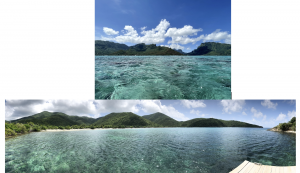
What processes occur in rubble patches?
Rubble patches are very much like beaches with lots of pebbles (Figure 2). The water motion from waves and currents move the rocks around frequently. Some pieces move more than others depending on their size. If a young organism attaches to these rocks for a permanent home, then there is a good chance its home will quickly become mobile as the rock gets pushed around in the waves. The organism may not be able to survive being tossed against other rocks or living on the underside of a rock with little access to light and food. Organisms that live in patches of coral rubble experience this instability, making it harder for them to settle in these areas. When coral rubble makes up a lot of the bottom area in a reef, it leaves fewer permanent options for new organisms to settle on.
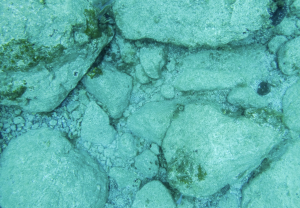
Rubble occurs even on healthy reefs; however, organisms such as sponges and calcareous algae can normally help stabilize the rubble by cementing the pieces together. Unfortunately, the same disturbances leading to the loss of corals have also reduced the ability of sponges and calcifying algae to cement the rubble together on modern reefs, thus causing more rubble motion.
Will corals survive if they settle onto a piece of rubble?
Corals that reproduce sexually release larvae in the water column. Then, the larvae search for a permanent place to settle and once they do, they can start to form a new coral colony. There is potential for larvae to settle onto a piece of rubble instead of the more stable reef structure, which could lead to an unpredictable outcome for the new coral. There are many reasons why corals may not be able to grow and survive on this unstable rubble. Corals have micro-algae in their cells which use photosynthesis to produce enough food for the coral to live on, and the production of that food relies on light from the sun. If, for example, a new coral landed on a piece of rubble and then the rubble got turned over, the coral would not receive any light until the piece returned upright. In addition, corals can be very delicate at younger ages (and hence smaller organisms) and can be easily killed when tossed against other pieces of rubble. Lastly, small corals are not as good at defending themselves against seaweed that has the tendency to take advantage of new space and dominate the rubble surface area. The seaweed may prevent corals from wanting to settle there or outcompete the corals once they are able to settle. These three reasons, among others, may prevent new corals from growing in rubble patches.
What did I do for my research in St. John?
In the Caribbean reefs of St. John, United States Virgin Islands, there has been a lot of destruction from intense hurricanes. Storms have led to a decrease in the number of living corals and an increase in large patches of rubble. These patches are made up of the carbonate reef that has been broken up into small pieces and some of the island’s volcanic rock that has fallen into the ocean as large boulders (Figure 3). Volcanic rock rubble is very dense and has a smooth surface. Contrastingly, carbonate reef rubble has a very uneven surface and can be more easily eroded. Through underwater surveys via scuba diving, any corals found on volcanic rocks versus carbonate reef rocks (7 to 100 centimeters) were identified and measured for size. Our thought was that larger pieces of rubble are more stable and thus have more corals on them.
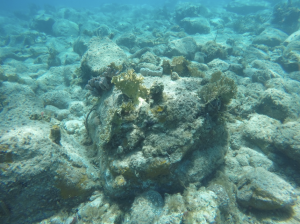
We found that there were more corals on larger rubble pieces because these larger pieces have a greater surface area and move infrequently, allowing for more corals to settle and mature. Surprisingly, rocks of similar size, despite their physical characteristics, had similar amounts of corals on them. This may be because the small holes in the surface area of the reef rock from erosion may attract corals to settle. Overall, corals will settle on unstable pieces of rubble of many sizes and materials, but smaller pieces of rubble may not support the long-term growth and survival of the settled corals.
What did I do for my research in Mo‘orea?
In Mo’orea, French Polynesia, the reefs look quite different. Instead of large boulders, rubble patches are made up of small branches of broken-off coral (Figure 4). Coral rubble is found in high quantities in the shallow reefs surrounding the island. The unstable pieces came from corals in the surrounding deeper reefs that were broken by storms, sometimes after the corals were killed by hot water. While the rubble pieces are much smaller (normally less than 20 centimeters) than rubble in St. John, new corals are able to settle on the surfaces. We tested the idea that low wave action areas will have more settled corals than high wave action areas.
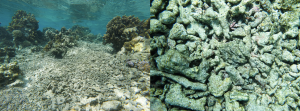
Through scuba surveys, we found that there were in fact less corals living on pieces of rubble in the high wave action area compared to the area of low activity. This is most likely due to the decreased turnover of the rubble. Most of the corals found in both areas were only from one coral species, Psammocora profundacella (Figure 5), which is interesting because we would have thought more coral species to be present.
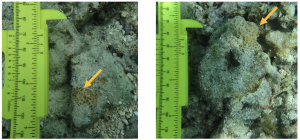
Why is this important?
In future years, rubble may become even larger parts of coral reef ecosystems as more corals are killed from disturbances. If the available space on coral reefs consists of unstable pieces of rubble that get moved and flipped over from wave action, then new corals will not be able to survive and repopulate the ecosystem. By comparing two different kinds of rubble patches, it seems that large pieces of rubble (~30 centimeters to 100 centimeters) or smaller pieces of rubble (~20 centimeters) in areas of lower wave activity can support new corals. Understanding the abundance and identity of corals living in rubble patches will continue to be critical in evaluating the status of reef recovery. Further research on the processes occurring within rubble patches of degraded reefs will need to be a prominent focus for coral reef ecology.
Acknowledgements and Permitting
California State University, Northridge, Mo’orea Coral Reef Long Term Ecological Research, The Polyp Lab, National Science Foundation (NSF), NSF grants-OCE 16-37396 and OCE 17-56678, The Explorers Club and The Rolex Explorers Grant. Research in Mo’orea was conducted under permits issues by the Haut-Commissariat de la République en Polynésie Francaise (DTRT) (Protocole d’Accueil 2005–2020), and research in St. John was completed under permits issued by the VI National Park.
I love writing of all kinds. As a PhD student at the Graduate School of Oceanography (URI), I use using genetic techniques to study phytoplankton diversity. I am interested in understanding how environmental stressors associated with climate change affect phytoplankton community dynamics and thus, overall ecosystem function. Prior to graduate school, I spent two years as a plankton analyst in the Marine Invasions Lab at the Smithsonian Environmental Research Center (SERC) studying phytoplankton in ballast water of cargo ships and gaining experience with phytoplankton taxonomy and culturing techniques. In my free time I enjoy making my own pottery and hiking in the White Mountains (NH).



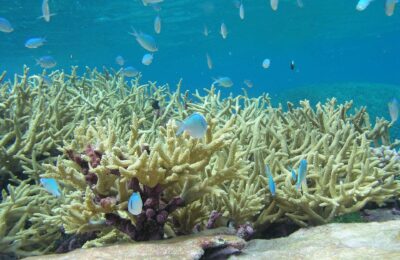
Have you published these results in a Journal? could you send me the link to download the paper. Regards
Great article. Thanks for talking the time and sharing